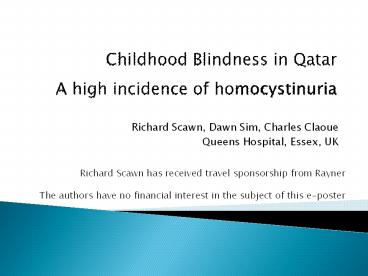Childhood Blindness in Qatar A high incidence of homocystinuria - PowerPoint PPT Presentation
Title:
Childhood Blindness in Qatar A high incidence of homocystinuria
Description:
Richard Scawn, Dawn Sim, Charles Claoue Queens Hospital, Essex, UK Richard Scawn has received travel sponsorship from Rayner The authors have no financial interest in ... – PowerPoint PPT presentation
Number of Views:43
Avg rating:3.0/5.0
Title: Childhood Blindness in Qatar A high incidence of homocystinuria
1
Childhood Blindness in QatarA high incidence of
homocystinuria
- Richard Scawn, Dawn Sim, Charles Claoue
- Queens Hospital, Essex, UK
Richard Scawn has received travel sponsorship
from Rayner The authors have no financial
interest in the subject of this e-poster
2
Aim and Background
- The aim of our study was to determine the causes
of childhood blindness in Qatar - One previous survey of blindness in adults and
children of Qatar was carried out in 1977 1 - The State of Qatar is an Arab emirate bordered by
Saudi Arabia and the Persian Gulf. - With the discovery of oil in the 1940s came large
changes in the socioeconomic wealth and
population growth. - It is estimated that only about 30 of the
countrys population (gt1.4million), are citizens. - All Qataris receive free medical care
3
Al-Noor Institute, Doha, Qatar
- Qatars only blind school
- Opened in September of 1998
- Provides a free education for citizens and
residents - Students with blindness, low vision, and special
needs
4
Methods
- A visiting Ophthalmologist examined all children
attending the Al-Noor Institute - The classification method used was that of the
British Ophthalmological Surveillance Unit (BOSU)
study 3 - (1) entirely unavoidable/untreatable,
- (2) entirely preventable, or
- (3) potentially treatable
- Outcomes of the consultation were grouped into 7
categories, including recommendations for - (1) surgery, (2) further investigations, (3)
low vision assessment, - (4) refraction / contact lens / glasses, (5)
mainstream school, - (6) blind school(7) blind school with special
needs
5
Results
- 211 children examined
6
Genetically-determined and Acquired causes of
blindness
Genetic causes Total () Acquired causes Total ()
Microphthalmia Lebera Amaurosis Retinitis Pigmentosa High Myopia Retinal detachment Congenital Cataracts Homocystinuria Congenital Glaucoma Albinism Congenital nystagmus Cone Dystrophy Squint/Refractive/Ambylopia Congenital Ptosis Corneal Opacities (Genetic) Neurological (Genetic) 18 (11) 17 (10) 5 (3) 13 (8) 8 (5) 14 (8) 41 (19) 17 (10) 4 (2) 5 (3) 2 (1) 10 (6) 1 (1) 17 (10) 7 (4) Corneal Opacities (Acquired) Neurological (Acquired) Retinopathy of Prematurity Squint / Ambylopia Congenital Ptosis Macular Coloboma 5 (12) 13 (30) 13 (30) 10 (23) 1 (2) 1 (2)
Total 168 (79) 43 (21)
7
Blindness by BOSU classification
Entirely unavoidable/untreatable 65 (30.8)
Entirely preventable 25 (11.8)
Retinopathy of prematurity Traumatic brain injury Refractive error/Ambylopia 13 1 11
Potentially treatable 121 (57.3)
High Myopia Retinal detachment Congenital Cataracts Homocystinuria Congenital Glaucoma Corneal opacities Cerebral palsy Hydrocephalus 13 8 14 41 17 22 4 2
8
Comparison of the causes of blindness with 1977
survey1
Categories 1977 Current Difference ()
Trachoma 36 0.5 -35.6
Infectious diseases 6.1 1.4 -4.7
Retinal disease 15.0 27 12.0
Trauma 23.8 1.4 -22.4
Genetically determined 17.0 79.8 62.6
9
Homocystinuria
- Homocystinuria was by far the most common single
diagnosis. - In this group further intervention via cataract
surgery or YAG laser capsulotomy required in 17
(n7), refraction or low vision assessment was
needed in 63 (n26). - A small number of these children (n4, 9.8) had
visual acuities that would enable them to attend
mainstream school.
10
Discussion
- Homocystinuria incidence
- Western Europe 1 in 20,000-60,000 4
- Norway 1 in 6400
- Qatar 1 in 3125 5
- Original Qatari tribes amount to about 200,000
people - Until the beginning of the 20th century the local
Qatari tribes were genetically isolated, with a
high level of intermarriage. - As in other Gulf States today it is still common
for first- or second-degree cousins to marry6.
54 in Qatari population7 - Consequent founder effects are responsible for
the high prevalence and unusual burden of
inherited disorders in Qatari population8
11
Discussion
- There has been a dramatic shift in the leading
cause of blindness following economic development
in Qatar - In our study genetic diseases account for almost
80 - Improved education, genetic counseling and
screening programs8 may reduce the future
incidence of genetically determined causes of
blindness in Qatar
12
References
- Hosni FA. Survey of major blinding conditions in
Qatar. Ophthalmologica. 1977 175(4)215-21. - Vision for Children. A global overview of
blindness, childhood and VISION2020 the right to
sight. World Health Organization (WHO) and the
International Agency for the Prevention of
Blindness (IAPB). www.v2020.org. Accessed April
2009. - Durnian JM, Cheeseman R, Kumar A, Raja V, Newman
W, Chandna A. Eye. Childhood sight impairment a
10-year picture. 2009 Feb 27. - Mudd SH, Levy HL, Kraus JP. Disorders of
transsulfuration. In Scriver CR, Beaudet AL, Sly
WS, Valle D, editors. The Metabolic and Molecular
Bases of Inherited Disease. New York
McGraw-Hill. 2001 p 2007-56. - El-Said MF, Badii R, Bessisso MS, Shahbek N,
El-Ali MG, El-Marikhie M, El-Zyoid M, Salem MS,
Bener A, Hoffmann GF, Zschocke J. A common
mutation in the CBS gene explains a high
incidence of homocystinuria in the Qatari
population. Hum Mutat. 2006 27(7)719. - Al-Gazali LI, Bener A, Abdulrazzaq YM, Micallef
R, al-Khayat AI, Gaber T. Consanguineous
marriages in the United Arab Emirates. J Biosoc
Sci 1997 29491-7. - Bener A, Alali KA.Consanguineous marriage in a
newly developed country the Qatari population. J
Biosoc Sci. 2006 38(2)239-46. - Lindner M, Abdoh G, Fang-Hoffmann J, Shabeck N,
Al-Sayrafi M, Al-Janahi M, Ho S, Abdelrahman MO,
Ben-Omran T, Bener A, Schulze A, Al-Rifai H,
Al-Thani G, Hoffmann GF. Implementation of
extended neonatal screening and a metabolic unit
in the State of Qatar developing and optimizing
strategies in cooperation with the Neonatal
Screening Center in Heidelberg. J Inherit Metab
Dis. 2007 30(4)522-9.































